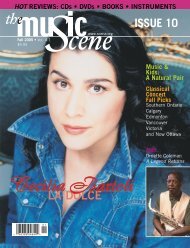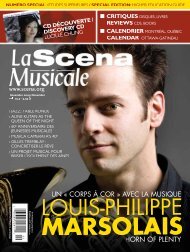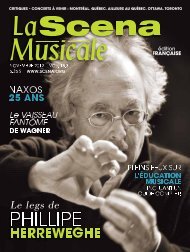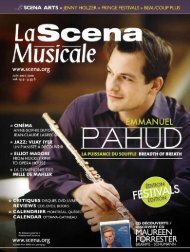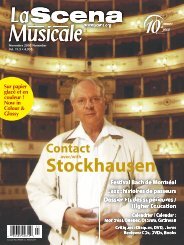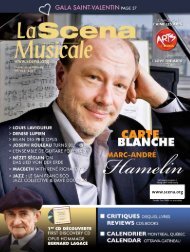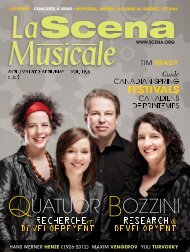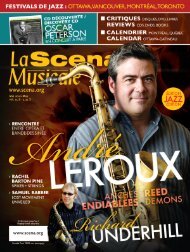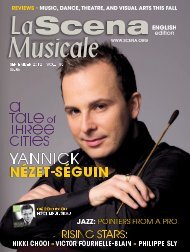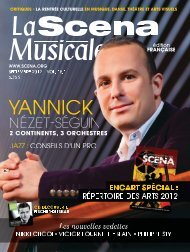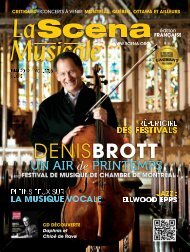Create successful ePaper yourself
Turn your PDF publications into a flip-book with our unique Google optimized e-Paper software.
REVIEWS<br />
CDs<br />
the dynamic markings are scrupulously rendered,<br />
though in tempi generally slower than usual. But<br />
it is a well-known fact that attention to detail,<br />
laudable though it may be, does not ensure a<br />
good rendering of a piece’s spirit. This is perhaps<br />
the case here: the emphasis on detail bars spontaneity,<br />
and the choice to emphasize effects in the<br />
work of a composer beloved for the contrary<br />
qualities is curious, at least. The quartet in D<br />
minor, a heart-rending cry, suffers more from<br />
this tendency than the “Dissonance.” Close miking<br />
produces at times an almost orchestral sound<br />
quality, with a huge cello. Let us return to the old<br />
Italians: let fluid, natural, moving song be again<br />
the order of the day! ALEXANDRE LAZARIDÈS<br />
Musica Vaticana: Musique Polychorale<br />
Studio de musique ancienne de Montréal/<br />
Christopher Jackson<br />
ATMA ACD2 2508 (57 min 5 s)<br />
★★★★★✩<br />
The works presented<br />
were almost all composed<br />
by Italian composers<br />
who were at one<br />
time directors of the<br />
Cappella Giulia in Rome<br />
between 1600 and 1743.<br />
The other well-known<br />
chapel in the eternal city was, of course, the<br />
Sistina. We are not in Rome for this recording,<br />
but happy in the church of Saint-Augustin in<br />
Mirabel, whose warm, hushed acoustics have<br />
been well captured. In this room, the rich<br />
voices and gentle expression of the ensemble<br />
lift the listener to heights of admiration and<br />
contemplation. The vocal parts call, respond,<br />
and circle each other in perpetual balance.<br />
SMAM’s sixteen voices are distinct enough that<br />
we can easily “visualize” each part and appreciate<br />
the counterpoint. The soloists are<br />
grouped in three or four distinct choirs, accompanied<br />
sometimes by a basso continuo<br />
(cello, harp, and organ). Two Benevoli motets<br />
for three and four soprano soloists are a fine<br />
contrast. They are brilliantly executed with joyful<br />
ornaments and immense virtuosity. Of especial<br />
note is the fugue which closes Pitoni’s<br />
Dixit Dominus for sixteen voices in four choirs:<br />
bravissimi!<br />
RENÉ F. AUCLAIR<br />
Schnittke: Quartets 1-4<br />
Molinari Quartet<br />
ATMA ACD22634 (2 CD; 103 min 20 s)<br />
★★★★★✩<br />
While the Molinari<br />
Quartet might not reach<br />
the dramatic heights of<br />
the Kronos Quartet nor<br />
attain the surgical precision<br />
of the Arditti String<br />
Quartet, they are more<br />
than competitive when<br />
it comes to timbre (and the competition is stiff<br />
indeed!). The varied instrumental colours are<br />
so perfectly fused that listening to the quartet<br />
is like listening to one soloist. This imaginary<br />
soloist isn’t immune to the occasional mistake<br />
or affectation, but we barely even hear such<br />
passing errors. The listener doesn’t linger on<br />
imperfections, but rather hangs on the shimmering<br />
tremolos of the first quartet, the melancholy<br />
of the second, the enveloping unisons of<br />
the third. If this imposing repertoire interests<br />
you, dive in post-haste. RENÉ BRICAULT<br />
Schumann: Piano Sonata No. 2 in G minor<br />
Op. 22/Fantasie in C major Op. 17<br />
Anton Kuerti, piano<br />
DOREMI DDR-6608<br />
★★★★★✩<br />
Over the years, Kuerti<br />
has recorded much of<br />
Robert Schumann’s<br />
piano music, including<br />
the chamber music and<br />
the Piano Concerto (CBC<br />
SMCD-5218). In all of<br />
these recordings, Kuerti<br />
has shown great empathy with the bipolar<br />
emotions expressed in the music. That is the<br />
case again here too but coupled with a remarkable<br />
command of subtleties of dynamics<br />
and tone that are so much a part of Schumann’s<br />
contribution to piano literature.<br />
The performances are enhanced immeasurably<br />
by a clear, rich piano sound. No doubt<br />
Kuerti’s own attention to the voicing of his instrument<br />
has something to do with it, but producers<br />
Jacob Harnoy and Clive Allen must be<br />
entitled to some of the credit. We can fairly assume<br />
that the acoustics of Willowdale United<br />
Church in Toronto made a contribution too.<br />
An interesting feature of this recording is the<br />
inclusion of the original Finale of Op. 22.<br />
Kuerti has chosen to add it as what he calls “a<br />
second scherzo.” I agree with him that the ending<br />
is too abrupt for the movement to be satisfying<br />
as a finale. The second finale has much<br />
greater cumulative power. PAUL E. ROBINSON<br />
Honens <strong>La</strong>ureate Series<br />
1) Bach: Goldberg Variations BWV 988<br />
Minsoo Sohn, piano<br />
2) Debussy/Holliger/Honegger/Ravel<br />
Gilles Vonsattel, piano<br />
3) Hindemith/Schoenberg/Stravinsky/Szymanowski<br />
Evgeny Starodubtsev, piano<br />
4) Schubert: Sonata in A major D.664/Drei<br />
Klavierstücke D.946/Fantasy in C major D.760/<br />
Allegretto in C minor D.915<br />
Georgy Tchaidze, piano<br />
★★★★★✩<br />
Given the space constraints and the vastly different<br />
repertoires, one is loathe to compare—<br />
let alone rank the discs, but suffice it to say<br />
each pianist brings his uniquely personal gift<br />
to the performance. Top on this reviewer’s<br />
personal list is Minsoo Sohn’s Goldberg Variations.<br />
After a stunning debut disc of Liszt<br />
transcriptions, Sohn goes from strength to<br />
strength with a recording that stands up to<br />
comparisons with the best—yes, even Glenn<br />
Gould’s “good standard” 1955 and 1981<br />
recordings. Striking is Sohn’s felicitous mix of<br />
singing tone, innate nobility of phrasing, and<br />
above all his poetic<br />
imagination. Having<br />
played this monumental<br />
work in live performances,<br />
it’s good that he<br />
has now committed it to<br />
disc. Another standout<br />
is the all-French program<br />
of Gilles Vonsattel<br />
who shows an uncommon<br />
affinity for Debussy<br />
and Ravel, played here<br />
with unfailingly ravishing<br />
tone, a wide spectrum<br />
of colours, and an<br />
altogether magical touch.<br />
The recorded sound is<br />
properly atmospheric if<br />
a touch too distant. As<br />
he explains in the liner<br />
notes, 2009 First <strong>La</strong>ureate<br />
Georgy Tchaidze is<br />
particularly drawn to<br />
Schubert and it shows.<br />
He does full justice to<br />
the joyous and elegant<br />
opening movement of<br />
the A major Sonata, his<br />
brisk tempo making the<br />
very familiar work<br />
sound fresh. To my ears,<br />
Tchaidze’s playing is most convincing in the<br />
more lyrical and introspective pieces, while<br />
the more dramatic and darker moments in<br />
pieces like the Fantasy in C major tend to be a<br />
touch overwrought. Starodubtsev’s “modern”<br />
program is perhaps the least familiar, but he<br />
plays it with great conviction and lyricism,<br />
brilliantly underscoring the kinship of Szymanowski<br />
and Hindemith with Debussy. It’s<br />
to his credit that even the Schoenberg sounds<br />
totally accessible to indifferent ears. The production<br />
values are exemplary—great sound,<br />
informative liner notes (particularly Eric<br />
Friesen’s Q&A with each pianist), and beautiful<br />
packaging—if only there were a photo or<br />
two of the recording sessions. These four pianists<br />
have already gained their rightful places<br />
among the most promising artists of today,<br />
and these releases are a testament to their ever<br />
developing artistry.<br />
JOSEPH K. SO<br />
TRANSLATION: MIRIAM CLOUTIER,<br />
NATALIE GAUTHIER, RONA NADLER,<br />
KARINE POZNANSKI<br />
DECEMBER 2011 / JANUARY 2012 45



